Validation of OMI HCHO Products Using MAX-DOAS observations from 2010 to 2016 in Xianghe, Beijing: Investigation of the Effects of Aerosols on Satellite Products
Abstract
1. Introduction
2. MAX-DOAS Measurements and Satellite Datasets
2.1. MAX-DOAS Instrument and Data Analysis
2.2. HCHO Versions from OMI
2.2.1. OMI-BIRA HCHO Product
2.2.2. OMI-NASA HCHO Product
2.3. Statistical Evaluation Methods
2.4. AMF Calculation
3. Validation of Satellite Datasets
3.1. Daily Comparisons
3.2. Monthly Comparisons
3.3. Aerosol Effects on the Satellite Results
3.3.1. HCHO AMF Dependence on the HCHO Profile
3.3.2. HCHO AMF Dependence on the AEC
3.3.3. HCHO AMF Dependence on the AEC and HCHO Profile Combination
3.3.4. HCHO AMF Dependence on AOD and SSA
3.4. Aerosol Correction
4. Discussion
5. Conclusions
Author Contributions
Funding
Acknowledgments
Conflicts of Interest
Appendix A
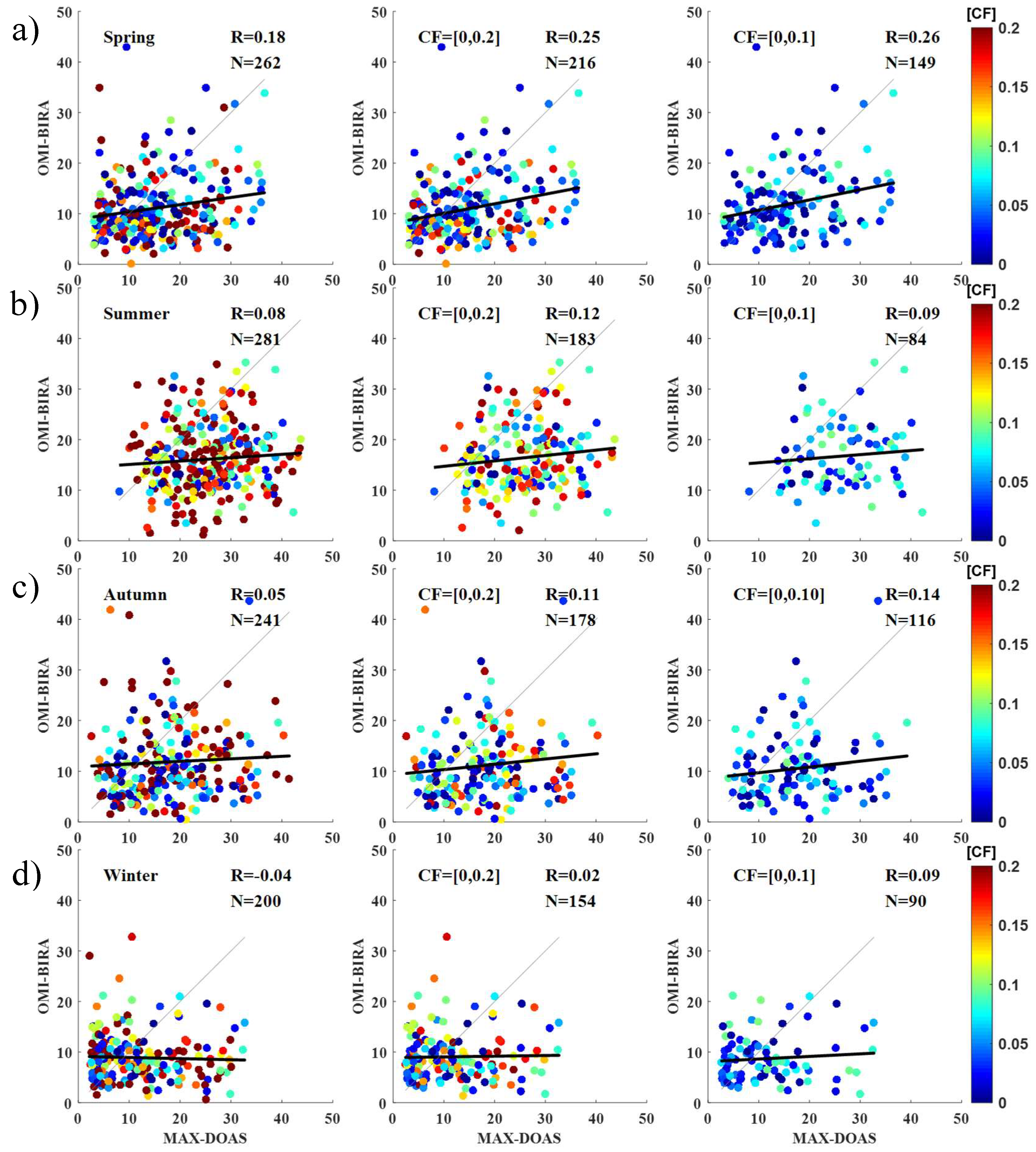
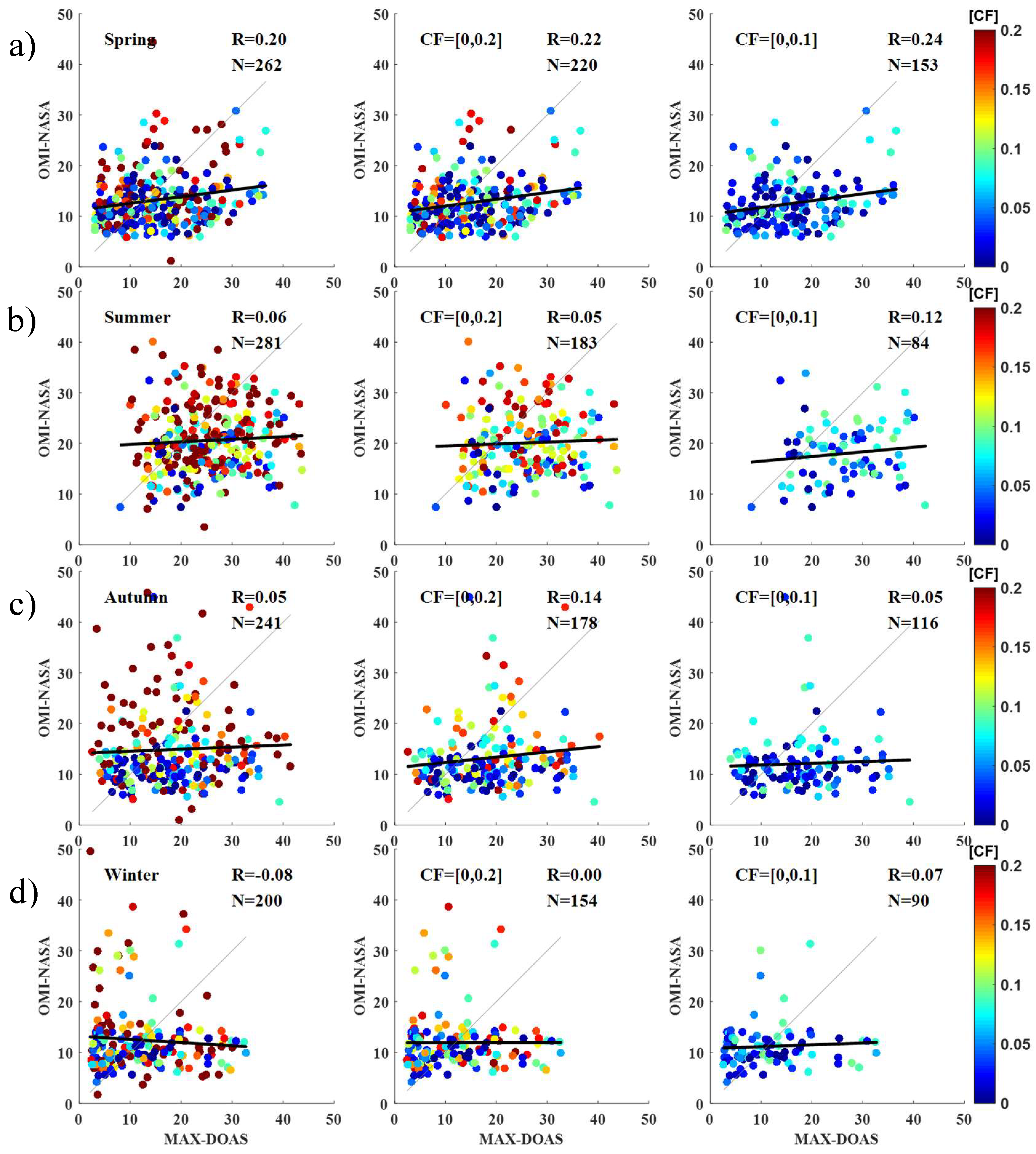
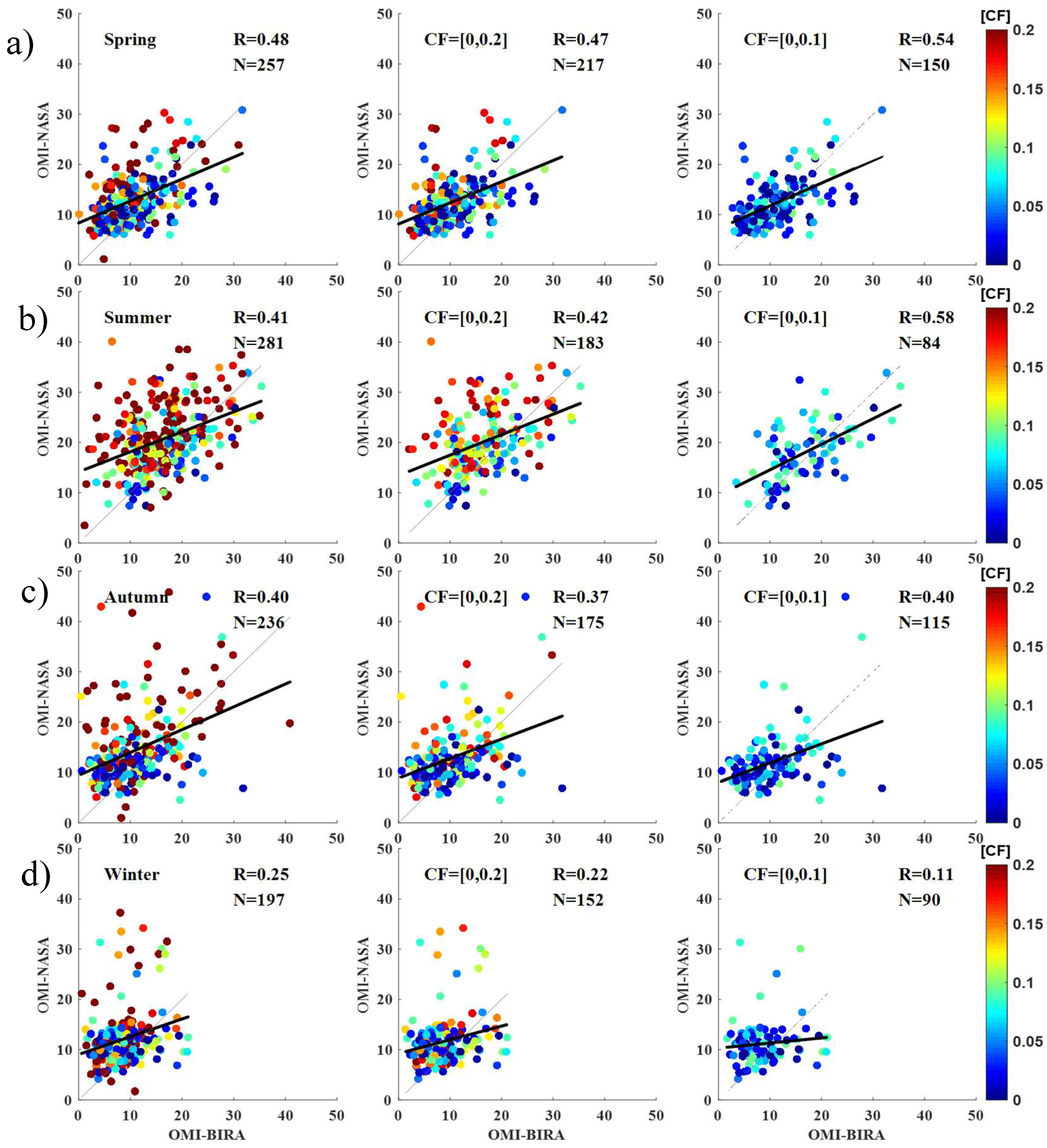

References
- Deng, X.J.; Zhou, X.J.; Wu, D.; Tie, X.X.; Tan, H.B.; Li, F.; Bi, X.Y.; Deng, T.; Jiang, D.H. Effect of atmospheric aerosol on surface ozone variation over the Pearl River Delta region. Sci. China Earth Sci. 2011, 54, 744–752. [Google Scholar] [CrossRef]
- Han, X.; Zhu, L.Y.; Wang, S.L.; Meng, X.Y.; Zhang, M.G.; Hu, J. Modeling study of impacts on surface ozone of regional transport and emissions reductions over North China Plain in summer 2015. Atmos. Chem. Phys. 2018, 18, 12207–12221. [Google Scholar] [CrossRef]
- Ministry of Ecology and Environment of the People’s Republic of China. China Environmental Status Bulletin. Available online: http://www.mee.gov.cn/hjzl/zghjzkgb/lnzghjzkgb/ (accessed on 18 January 2019).
- Houweling, S.; Dentener, F.; Lelieveld, J. The impact of nonmethane hydrocarbon compounds on tropospheric photochemistry. J. Geophys. Res. Atmos. 1998, 103, 10673–10696. [Google Scholar] [CrossRef]
- Poisson, N.; Kanakidou, M.; Crutzen, P.J. Impact of non-methane hydrocarbons on tropospheric chemistry and the oxidizing power of the global troposphere: 3-dimensional modelling results. J. Atmos. Chem. 2000, 36, 157–230. [Google Scholar] [CrossRef]
- Cheng, N.; Chen, Z.; Sun, F.; Sun, R.; Dong, X.; Xie, X.; Xu, C. Ground ozone concentrations over Beijing from 2004 to 2015: Variation patterns, indicative precursors and effects of emission-reduction. Environ. Pollut. 2018, 237, 262–274. [Google Scholar] [CrossRef] [PubMed]
- Kanakidou, M.; Seinfeld, J.; Pandis, S.; Barnes, I.; Dentener, F.; Facchini, M.; Dingenen, R.V.; Ervens, B.; Nenes, A.; Nielsen, C. Organic aerosol and global climate modelling: A review. Atmos. Chem. Phys. 2005, 5, 1053–1123. [Google Scholar] [CrossRef]
- Duncan, B.N.; Yoshida, Y.; Olson, J.R.; Sillman, S.; Martin, R.V.; Lamsal, L.; Hu, Y.; Pickering, K.E.; Retscher, C.; Allen, D.J. Application of OMI observations to a space-based indicator of NOx and VOC controls on surface ozone formation. Atmos. Environ. 2010, 44, 2213–2223. [Google Scholar] [CrossRef]
- Parrish, D.; Ryerson, T.; Mellqvist, J.; Johansson, J.; Fried, A.; Richter, D.; Walega, J.; Washenfelder, R.D.; De Gouw, J.; Peischl, J. Primary and secondary sources of formaldehyde in urban atmospheres: Houston Texas region. Atmos. Chem. Phys. 2012, 12, 3273–3288. [Google Scholar] [CrossRef]
- De Smedt, I.; Müller, J.-F.; Stavrakou, T.; Van Der A, R.; Eskes, H.; Van Roozendael, M. Twelve years of global observations of formaldehyde in the troposphere using GOME and SCIAMACHY sensors. Atmos. Chem. Phys. 2008, 8, 4947–4963. [Google Scholar] [CrossRef]
- Anderson, L.G.; Lanning, J.A.; Barrell, R.; Miyagishima, J.; Jones, R.H.; Wolfe, P. Sources and sinks of formaldehyde and acetaldehyde: An analysis of Denver’s ambient concentration data. Atmos. Environ. 1996, 30, 2113–2123. [Google Scholar] [CrossRef]
- Chance, K.; Palmer, P.I.; Spurr, R.J.; Martin, R.V.; Kurosu, T.P.; Jacob, D.J. Satellite observations of formaldehyde over North America from GOME. Geophys. Res. Lett. 2000, 27, 3461–3464. [Google Scholar] [CrossRef]
- De Smedt, I.; Van Roozendael, M.; Stavrakou, T.; Müller, J.; Lerot, C.; Theys, N.; Valks, P.; Hao, N.; Van Der A, R. Improved retrieval of global tropospheric formaldehyde columns from GOME-2/MetOp-A addressing noise reduction and instrumental degradation issues. Atmos. Meas. Tech. 2012, 5, 2933–2949. [Google Scholar] [CrossRef]
- González Abad, G.; Liu, X.; Chance, K.; Wang, H.; Kurosu, T.; Suleiman, R. Updated Smithsonian Astrophysical Observatory Ozone Monitoring Instrument (SAO OMI) formaldehyde retrieval. Atmos. Meas. Tech. 2015, 8, 19–32. [Google Scholar] [CrossRef]
- De Smedt, I.; Stavrakou, T.; Hendrick, F.; Danckaert, T.; Vlemmix, T.; Pinardi, G.; Theys, N.; Lerot, C.; Gielen, C.; Vigouroux, C. Diurnal, seasonal and long-term variations of global formaldehyde columns inferred from combined OMI and GOME-2 observations. Atmos. Chem. Phys. 2015, 15, 12241–12300. [Google Scholar] [CrossRef]
- González Abad, G.; Vasilkov, A.; Seftor, C.; Liu, X.; Chance, K. Smithsonian Astrophysical Observatory Ozone Mapping and Profiler Suite (SAO OMPS) formaldehyde retrieval. Atmos. Meas. Tech. 2016, 9, 2797–2812. [Google Scholar] [CrossRef]
- Li, C.; Joiner, J.; Krotkov, N.A.; Dunlap, L. A new method for global retrievals of HCHO total columns from the Suomi National Polar-orbiting Partnership Ozone Mapping and Profiler Suite. Geophys. Res. Lett. 2015, 42, 2515–2522. [Google Scholar] [CrossRef]
- De Smedt, I.; Theys, N.; Yu, H.; Danckaert, T.; Lerot, C.; Compernolle, S.; Van Roozendael, M.; Richter, A.; Hilboll, A.; Peters, E.; et al. Algorithm theoretical baseline for formaldehyde retrievals from S5P TROPOMI and from the QA4ECV project. Atmos. Meas. Tech. 2018, 11, 2395–2426. [Google Scholar] [CrossRef]
- De Smedt, I.; Stavrakou, T.; Muller, J.F.; van der A, R.J.; Van Roozendael, M. Trend detection in satellite observations of formaldehyde tropospheric columns. Geophys. Res. Lett. 2010, 37, L18808. [Google Scholar] [CrossRef]
- Fu, T.M.; Jacob, D.J.; Palmer, P.I.; Chance, K.; Wang, Y.X.; Barletta, B.; Blake, D.R.; Stanton, J.C.; Pilling, M.J. Space-based formaldehyde measurements as constraints on volatile organic compound emissions in east and south Asia and implications for ozone. J. Geophys. Res. Atmos. 2007, 112. [Google Scholar] [CrossRef]
- Stavrakou, T.; Müller, J.-F.; Smedt, I.D.; Roozendael, M.V.; Van Der Werf, G.; Giglio, L.; Guenther, A. Global emissions of non-methane hydrocarbons deduced from SCIAMACHY formaldehyde columns through 2003–2006. Atmos. Chem. Phys. 2009, 9, 3663–3679. [Google Scholar] [CrossRef]
- Stavrakou, T.; Müller, J.-F.; Smedt, I.D.; Roozendael, M.V.; Van der Werf, G.; Giglio, L.; Guenther, A. Evaluating the performance of pyrogenic and biogenic emission inventories against one decade of space-based formaldehyde columns. Atmos. Chem. Phys. 2009, 9, 1037–1060. [Google Scholar] [CrossRef]
- Wang, Y.; Beirle, S.; Lampel, J.; Koukouli, M.; De Smedt, I.; Theys, N.; Li, A.; Wu, D.X.; Xie, P.H.; Liu, C.; et al. Validation of OMI, GOME-2A and GOME-2B tropospheric NO2, SO2 and HCHO products using MAX-DOAS observations from 2011 to 2014 in Wuxi, China: Investigation of the effects of priori profiles and aerosols on the satellite products. Atmos. Chem. Phys. 2017, 17, 5007–5033. [Google Scholar] [CrossRef]
- Lorente, A.; Boersma, K.F.; Yu, H.; Dörner, S.; Hilboll, A.; Richter, A.; Liu, M.; Lamsal, L.N.; Barkley, M.; De Smedt, I. Structural uncertainty in air mass factor calculation for NO2 and HCHO satellite retrievals. Atmos. Meas. Tech. 2017, 10, 759–782. [Google Scholar] [CrossRef]
- Lin, J.T.; Martin, R.V.; Boersma, K.F.; Sneep, M.; Stammes, P.; Spurr, R.; Wang, P.; Van Roozendael, M.; Clémer, K.; Irie, H. Retrieving tropospheric nitrogen dioxide over China from the Ozone Monitoring Instrument: Effects of aerosols, surface reflectance anisotropy and vertical profile of nitrogen dioxide. Atmos. Chem. Phys. 2014, 14, 1441–1461. [Google Scholar] [CrossRef]
- Lin, J.T.; Liu, M.Y.; Xin, J.Y.; Boersma, K.F.; Spurr, R.; Martin, R.; Zhang, Q. Influence of aerosols and surface reflectance on satellite NO2 retrieval: Seasonal and spatial characteristics and implications for NOx emission constraints. Atmos. Chem. Phys. 2015, 15, 12653–12714. [Google Scholar] [CrossRef]
- Boersma, K.F.; Eskes, H.J.; Dirksen, R.J.; Veefkind, J.P.; Stammes, P.; Huijnen, V.; Kleipool, Q.L.; Sneep, M.; Claas, J.; Leitão, J.; et al. An improved tropospheric NO2 column retrieval algorithm for the Ozone Monitoring Instrument. Atmos. Meas. Tech. 2011, 4, 2329–2388. [Google Scholar] [CrossRef]
- Hendrick, F.; Muller, J.F.; Clemer, K.; Wang, P.; De Maziere, M.; Fayt, C.; Gielen, C.; Hermans, C.; Ma, J.Z.; Pinardi, G.; et al. Four years of ground-based MAX-DOAS observations of HONO and NO2 in the Beijing area. Atmos. Chem. Phys. 2014, 14, 765–781. [Google Scholar] [CrossRef]
- Vlemmix, T.; Hendrick, F.; Pinardi, G.; De Smedt, I.; Fayt, C.; Hermans, C.; Piters, A.; Wang, P.; Levelt, P.; Van Roozendael, M. MAX-DOAS observations of aerosols, formaldehyde and nitrogen dioxide in the Beijing area: Comparison of two profile retrieval approaches. Atmos. Meas. Tech. 2015, 8, 941–963. [Google Scholar] [CrossRef]
- Wang, T.; Hendrick, F.; Wang, P.; Tang, G.; Clemer, K.; Yu, H.; Fayt, C.; Hermans, C.; Gielen, C.; Muller, J.F.; et al. Evaluation of tropospheric SO2 retrieved from MAX-DOAS measurements in Xianghe, China. Atmos. Chem. Phys. 2014, 14, 11149–11164. [Google Scholar] [CrossRef]
- Clemer, K.; Van Roozendael, M.; Fayt, C.; Hendrick, F.; Hermans, C.; Pinardi, G.; Spurr, R.; Wang, P.; De Maziere, M. Multiple wavelength retrieval of tropospheric aerosol optical properties from MAXDOAS measurements in Beijing. Atmos. Meas. Tech. 2010, 3, 863–878. [Google Scholar] [CrossRef]
- Zhu, L.; Jacob, D.J.; Kim, P.S.; Fisher, J.A.; Yu, K.; Travis, K.R.; Mickley, L.J.; Yantosca, R.M.; Sulprizio, M.P.; De Smedt, I.; et al. Observing atmospheric formaldehyde (HCHO) from space: Validation and intercomparison of six retrievals from four satellites (OMI, GOME2A, GOME2B, OMPS) with SEAC(4)RS aircraft observations over the southeast US. Atmos. Chem. Phys. 2016, 16, 13477–13490. [Google Scholar] [CrossRef]
- Barkley, M.; Abad, G.G.; Kurosu, T.P.; Spurr, R.; Torbatian, S.; Lerot, C. OMI air-quality monitoring over the Middle East. Atmos. Chem. Phys. 2017, 17, 4687–4709. [Google Scholar] [CrossRef]
- Rozanov, A.; Rozanov, V.; Buchwitz, M.; Kokhanovsky, A.; Burrows, J.P. SCIATRAN 2.0—A new radiative transfer model for geophysical applications in the 175–2400 nm spectral region. Adv. Space Res. 2005, 36, 1015–1019. [Google Scholar] [CrossRef]
- Rozanov, V.V.; Rozanov, A.V.; Kokhanovsky, A.A.; Burrows, J.P. Radiative transfer through terrestrial atmosphere and ocean: Software package SCIATRAN. J. Quant. Spectrosc. Radiat. Transf. 2014, 133, 13–71. [Google Scholar] [CrossRef]
- Wittrock, F. The Retrieval of Oxygenated Volatile Organic Compounds by remote Sensing Techniques. Doctoral dissertation, Universität Bremen, Bremen, Germany, 2006. [Google Scholar]
- Acarreta, J.; De Haan, J.; Stammes, P. Cloud pressure retrieval using the O2-O2 absorption band at 477 nm. J. Geophys. Res. Atmos. 2004, 109, D05204. [Google Scholar] [CrossRef]
- Xiao, H.; Zhang, M.; Zhu, L.; Liren, X.U. Model Analysis of Influences of Aerosol Mixing State upon Its Optical Properties in East Asia. Adv. Atmos. Sci. 2013, 30, 1201–1212. [Google Scholar]
- Han, X.; Zhang, M.; Gao, J.; Wang, S.; Chai, F. Modeling analysis of the seasonal characteristics of haze formation in Beijing. Atmos. Chem. Phys. 2014, 14, 10231–10248. [Google Scholar] [CrossRef]
- Byun, D.; Schere, K.L. Review of the Governing Equations, Computational Algorithms, and Other Components of the Models-3 Community Multiscale Air Quality (CMAQ) Modeling System. Appl. Mech. Rev. 2006, 59, 51–77. [Google Scholar] [CrossRef]
- Stephens, G.L.; Vane, D.G.; Boain, R.; Mace, G.; Sassen, K.; Wang, Z.; Illingworth, A.; Oconnor, E.; Rossow, W.; Durden, S.L. The Cloudsat Mission and the EOS Constellation: A New Dimension of Space-Based Observation of Clouds and Precipitation; NASA: Washington, DC, USA, 2001. [Google Scholar]
- Li, J.; Han, Z. Aerosol vertical distribution over east China from RIEMS-Chem simulation in comparison with CALIPSO measurements. Atmos. Environ. 2016, 143, 177–189. [Google Scholar] [CrossRef]
- Wu, T.; Fan, M.; Tao, J.; Su, L.; Wang, P.; Liu, D.; Li, M.; Han, X.; Chen, L. Aerosol Optical Properties over China from RAMS-CMAQ Model Compared with CALIOP Observations. Atmosphere 2017, 8, 201. [Google Scholar] [CrossRef]
- Torres, O.; Ahn, C.; Chen, Z. Improvements to the OMI near-UV aerosol algorithm using A-train CALIOP and AIRS observations. Atmos. Meas. Tech. 2013, 6, 3257–3270. [Google Scholar] [CrossRef]
- Ahn, C.; Torres, O.; Jethva, H. Assessment of OMI near-UV aerosol optical depth over land. J. Geophys. Res. Atmos. 2014, 119, 2457–2473. [Google Scholar] [CrossRef]
- Zhang, W.H.; Gu, X.F.; Xu, H.; Yu, T.; Zheng, F.J. Assessment of OMI near-UV aerosol optical depth over Central and East Asia. J. Geophys. Res. Atmos. 2016, 121, 382–398. [Google Scholar] [CrossRef]
- Kang, L.T.; Chen, S.Y.; Huang, J.P.; Zhao, S.M.; Ma, X.J.; Yuan, T.G.; Zhang, X.R.; Xie, T.T. The Spatial and Temporal Distributions of Absorbing Aerosols over East Asia. Remote Sens. 2017, 9, 20. [Google Scholar] [CrossRef]
- Lamsal, L.N.; Krotkov, N.A.; Celarier, E.A.; Swartz, W.H.; Pickering, K.E.; Bucsela, E.J.; Gleason, J.F.; Martin, R.V.; Philip, S.; Irie, H.; et al. Evaluation of OMI operational standard NO2 column retrievals using in situ and surface-based NO2 observations. Atmos. Chem. Phys. 2014, 14, 11587–11609. [Google Scholar] [CrossRef]
- Veefkind, J.P.; de Haan, J.F.; Sneep, M.; Levelt, P.F. Improvements to the OMI O2-O2 operational cloud algorithm and comparisons with ground-based radar-lidar observations. Atmos. Meas. Tech. 2016, 9, 6035–6049. [Google Scholar] [CrossRef]
- Theys, N.; Van Roozendael, M.; Hendrick, F.; Yang, X.; De Smedt, I.; Richter, A.; Begoin, M.; Errera, Q.; Johnston, P.V.; Kreher, K.; et al. Global observations of tropospheric BrO columns using GOME-2 satellite data. Atmos. Chem. Phys. 2011, 11, 1791–1811. [Google Scholar] [CrossRef]
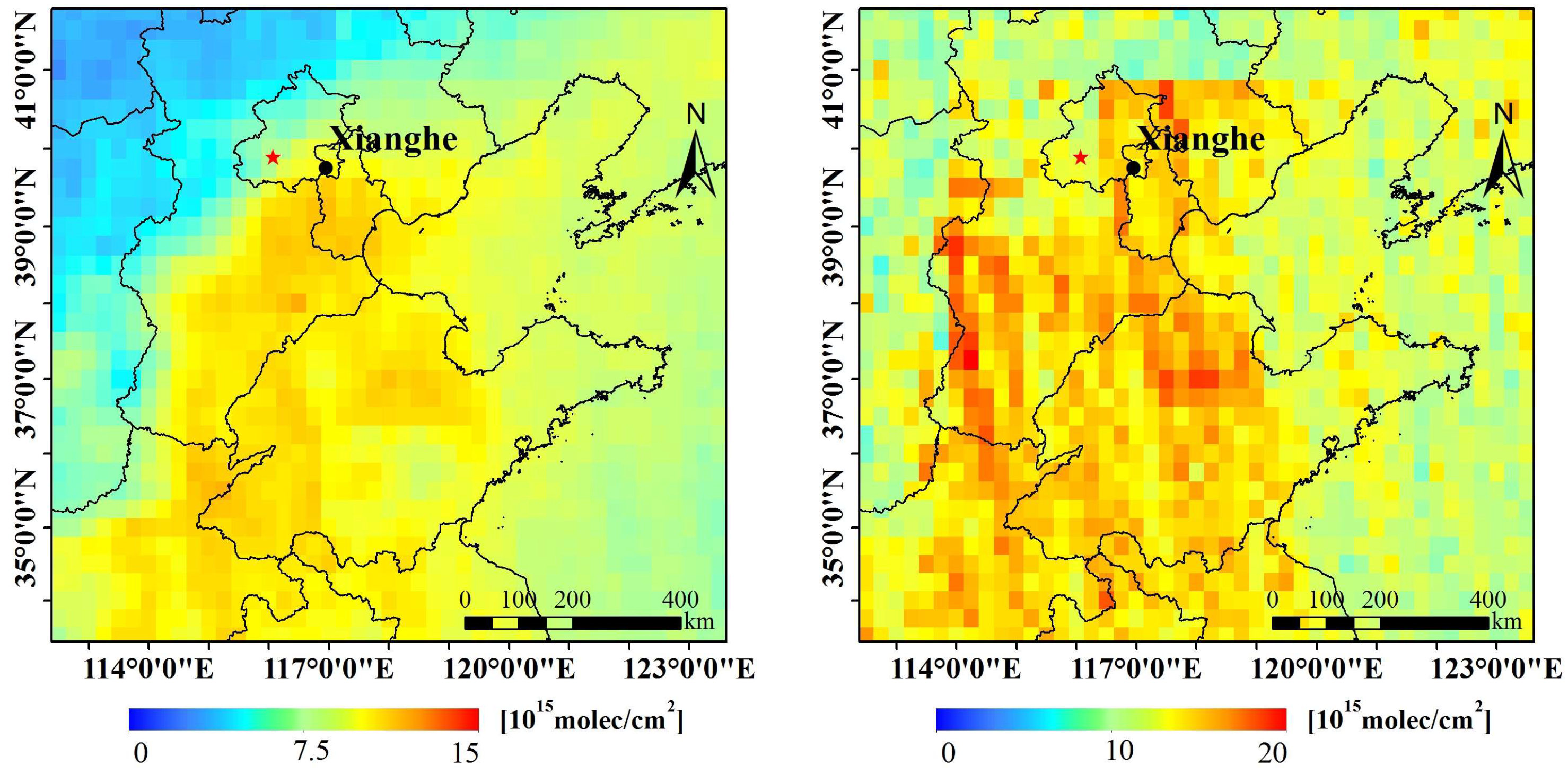
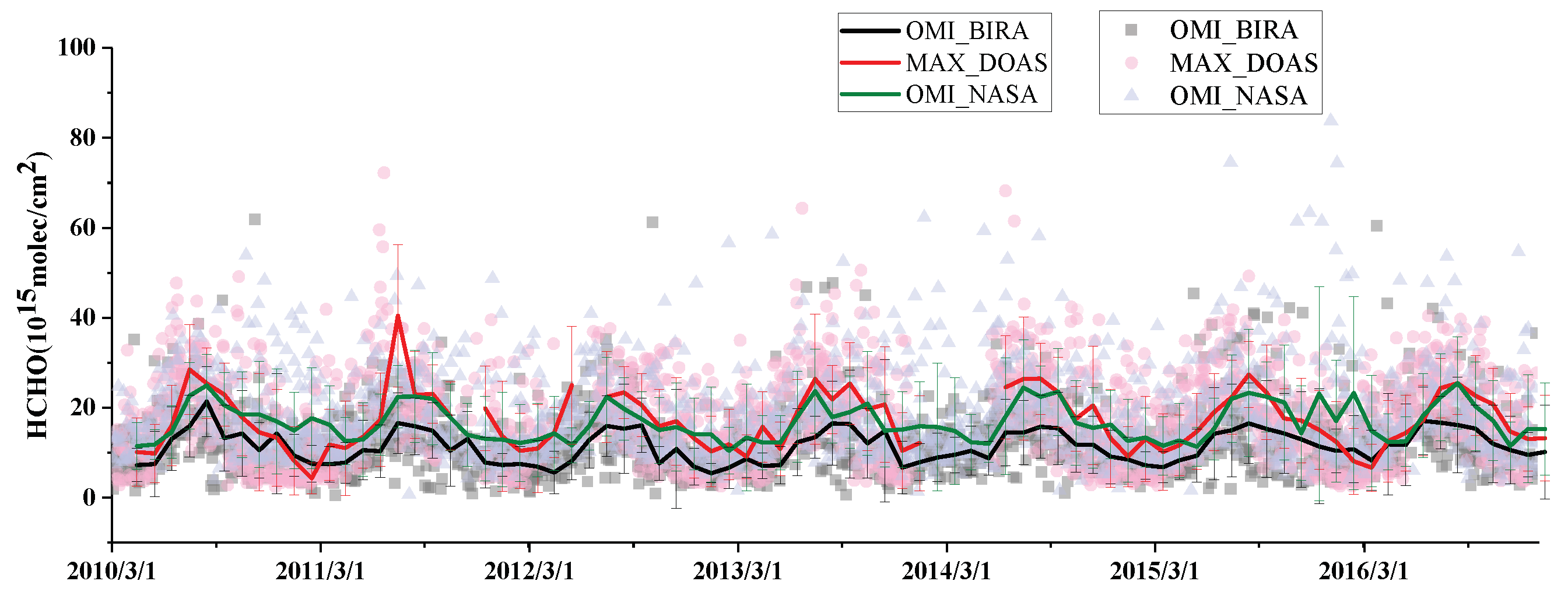
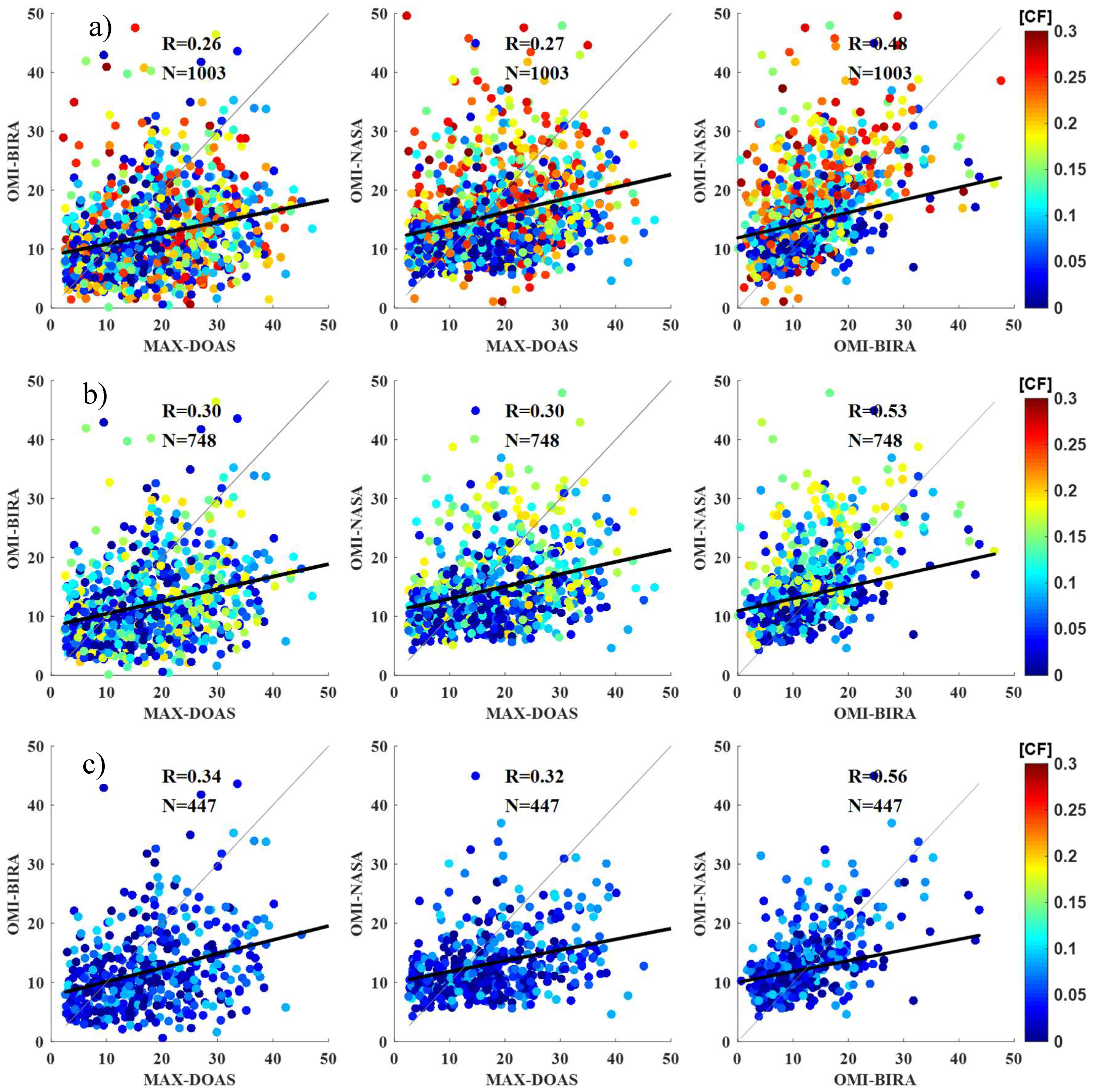
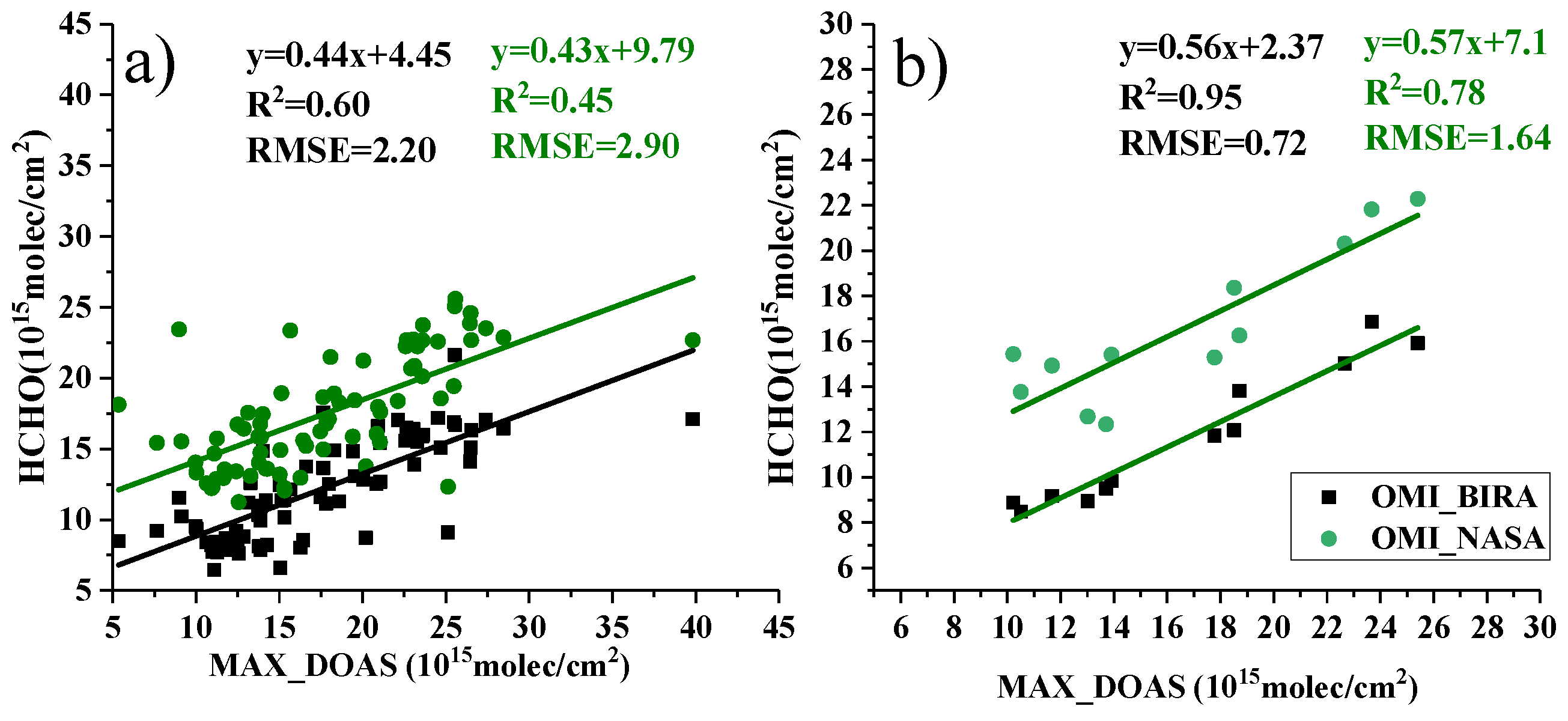
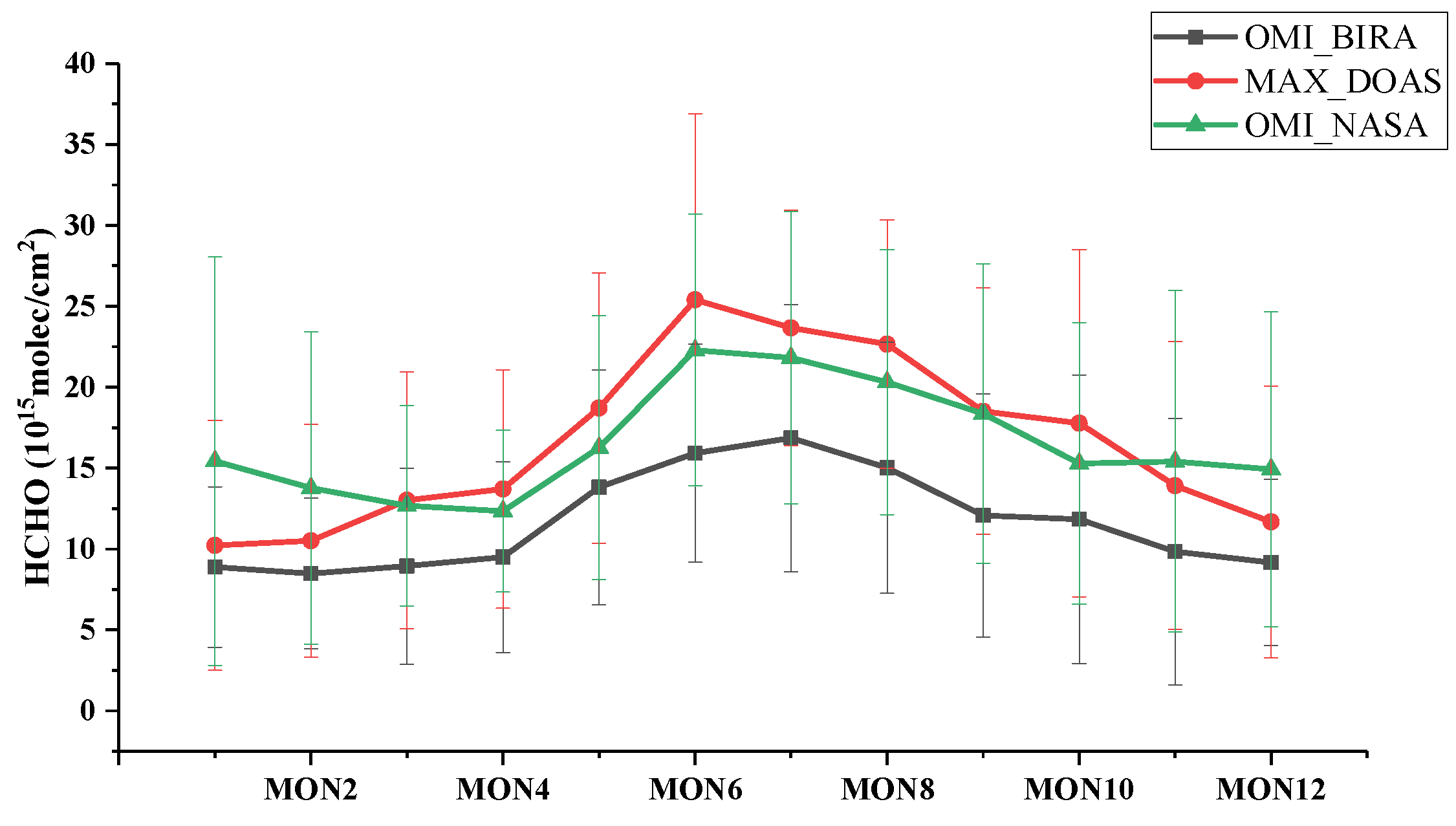

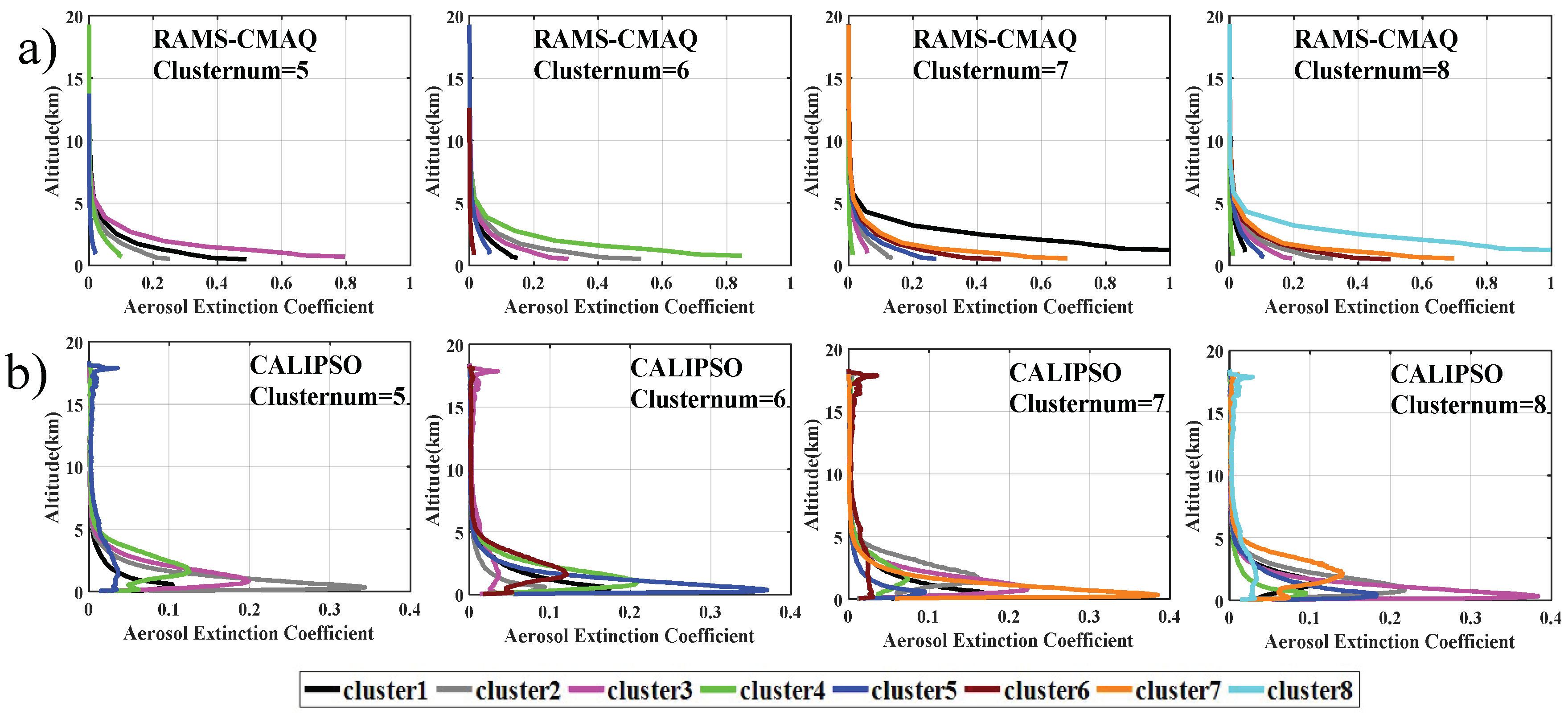
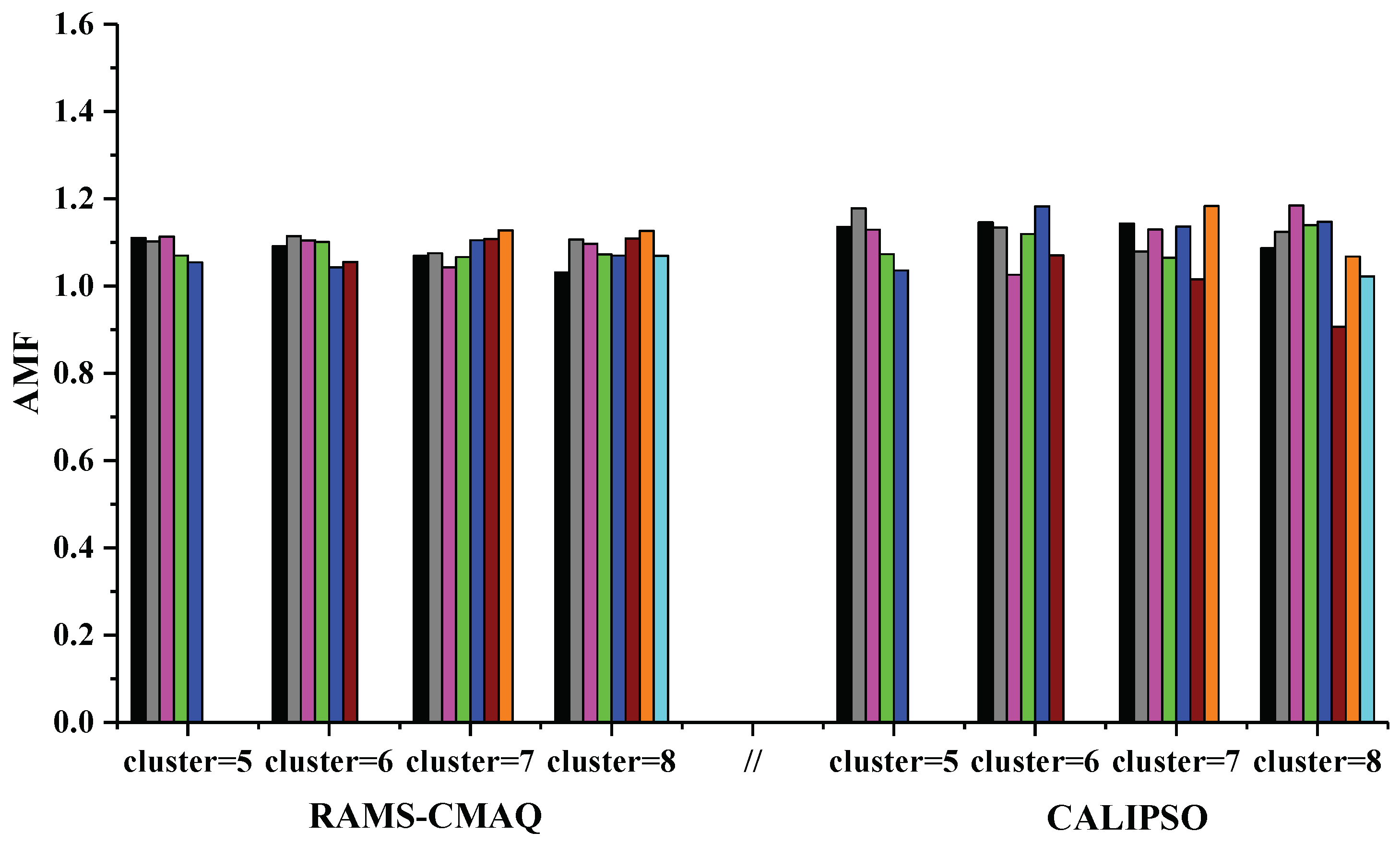
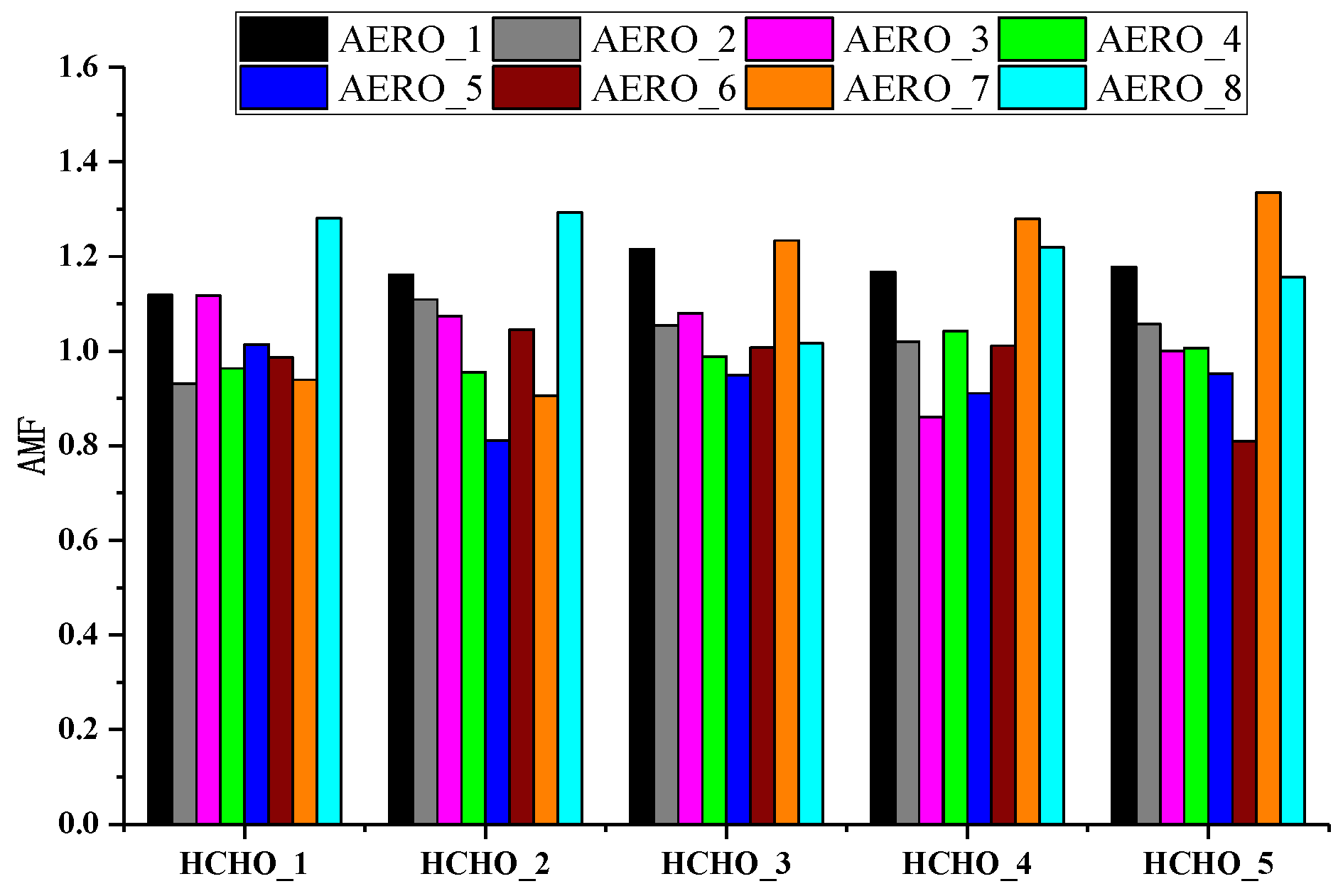
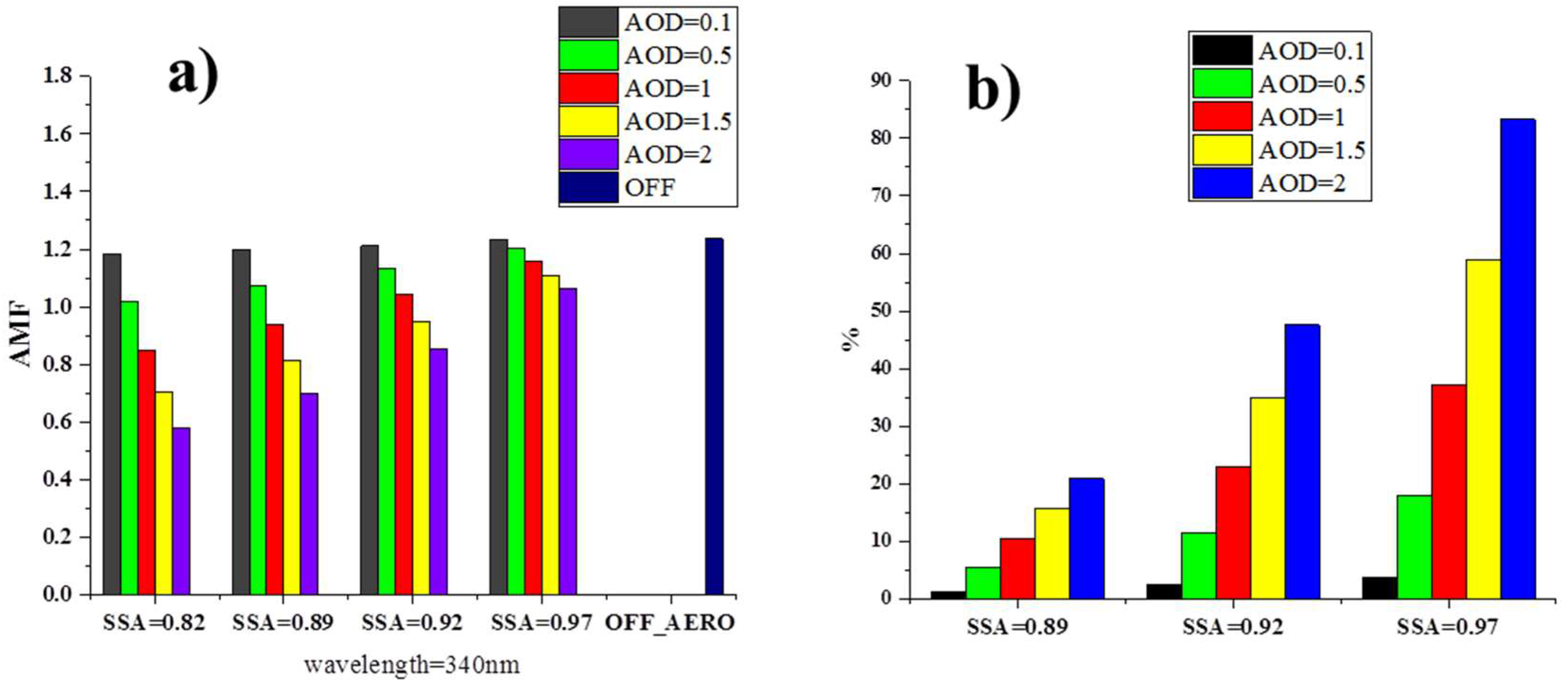
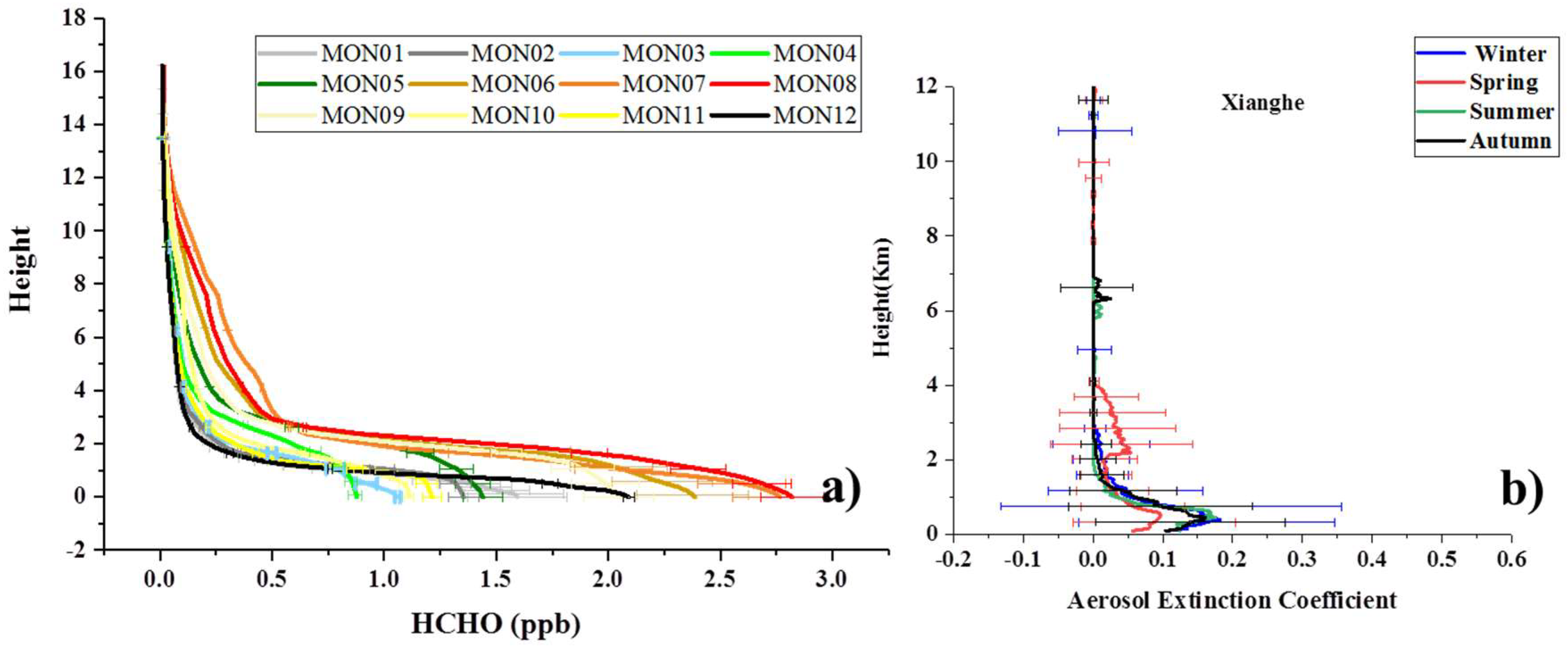
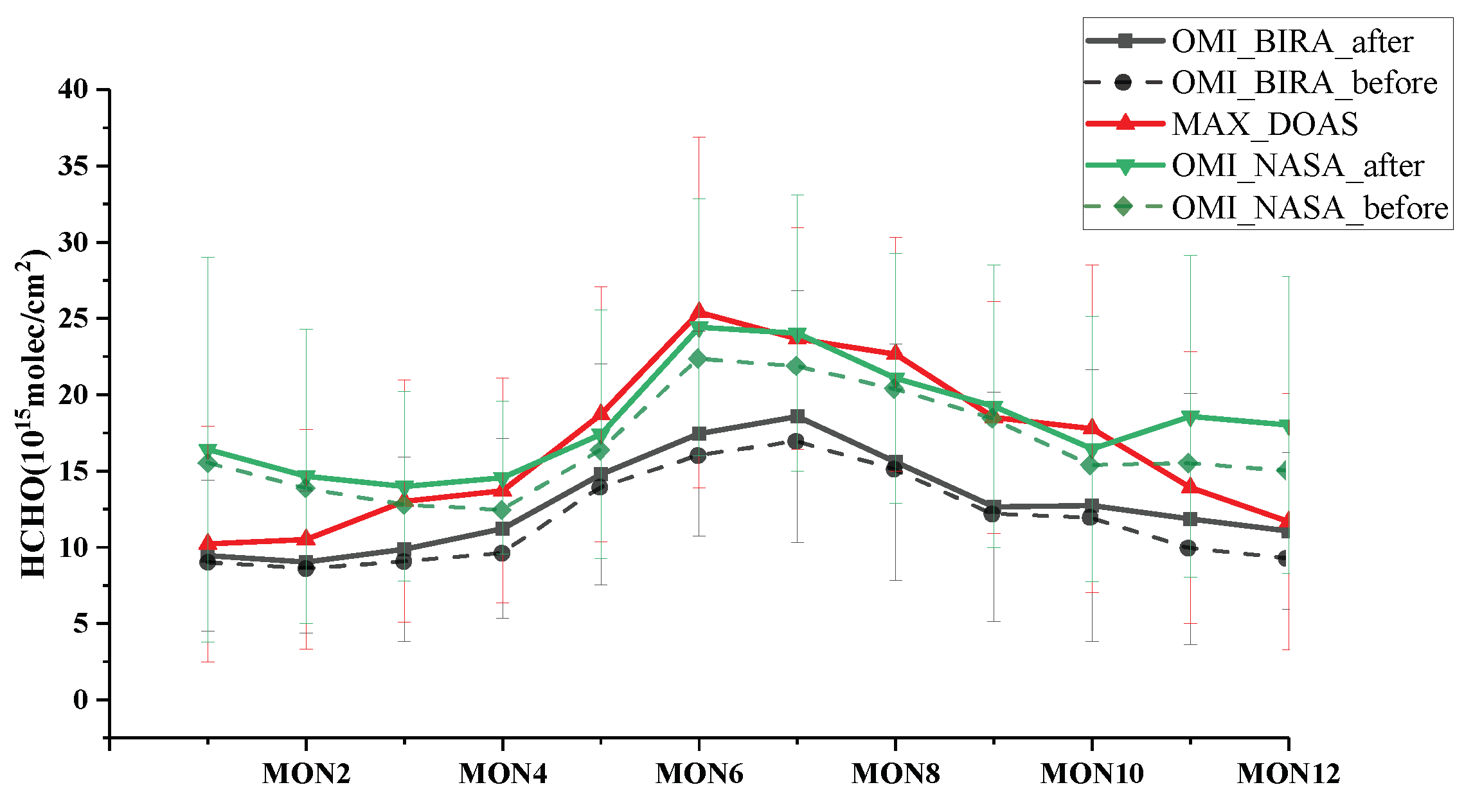
| OMI-BIRA (1015 molec/cm2) | MAX-DOAS (1015 molec/cm2) | OMI-NASA (1015 molec/cm2) | Difference (OMI-BIRA& MAX_DOAS) | Difference (OMI-NASA& MAX_DOAS) | ||||||
|---|---|---|---|---|---|---|---|---|---|---|
| HCHO | 1σ | HCHO | 1σ | HCHO | 1σ | Abs_DF | Rel_DF (%) | Abs_DF | Rel_DF (%) | |
| MON01 | 8.89 | 4.96 | 10.22 | 7.73 | 15.43 | 12.62 | −1.34 | 5.21 | −15.05 | 33.74 |
| MON2 | 8.48 | 4.65 | 10.51 | 7.20 | 13.77 | 9.64 | −2.03 | 3.26 | −23.97 | 23.66 |
| MON3 | 8.95 | 6.06 | 13.01 | 7.93 | 12.68 | 6.21 | −4.06 | −0.33 | −45.39 | −2.62 |
| MON4 | 9.50 | 5.90 | 13.71 | 7.37 | 12.34 | 5.00 | −4.20 | −1.37 | −44.22 | −11.10 |
| MON5 | 13.81 | 7.25 | 18.71 | 8.35 | 16.26 | 8.14 | −4.90 | −2.45 | −35.45 | −15.05 |
| MON6 | 15.93 | 6.72 | 25.40 | 11.50 | 22.29 | 8.41 | −9.47 | −3.11 | −59.47 | −13.96 |
| MON7 | 16.86 | 8.24 | 23.67 | 7.26 | 21.82 | 9.05 | −6.82 | −1.85 | −40.43 | −8.50 |
| MON8 | 15.02 | 7.75 | 22.66 | 7.67 | 20.31 | 8.19 | −7.64 | −2.35 | −50.90 | −11.57 |
| MON9 | 12.07 | 7.52 | 18.51 | 7.61 | 18.36 | 9.25 | −6.44 | −0.15 | −53.35 | −0.83 |
| MON10 | 11.84 | 8.92 | 17.78 | 10.73 | 15.29 | 8.70 | −5.94 | −2.49 | −50.16 | −16.28 |
| MON11 | 9.83 | 8.24 | 13.92 | 8.90 | 15.41 | 10.55 | −4.08 | 1.49 | −41.52 | 9.69 |
| MON12 | 9.17 | 5.14 | 11.68 | 8.40 | 14.93 | 9.73 | −2.51 | 3.25 | −27.40 | 21.79 |
| OMI-BIRA | OMI-NASA | ||
|---|---|---|---|
| Chemical transport model | IMAGES | GEOS-Chem | |
| Background correction | Destriping correction | Row-dependent median HCHO in the equatorial Pacific (15°S–15°N,180–240°E) | GEOS-Chem simulated HCHO in reference section (90°S–90°N, 140–160°W), with 2.0° (latitude) 2.5° (longitude) |
| Zonal reference sector correction | A polynomial in the entire reference sector (90° S-90°N, 180–240°E) | ||
| BrO interference consideration | Pre-fit BrO slant columns, then fixed BrO values during HCHO retrieval | Implicit in the GEOS-Chem simulation in reference section | |
| Reference | [15] | [14] | |
© 2019 by the authors. Licensee MDPI, Basel, Switzerland. This article is an open access article distributed under the terms and conditions of the Creative Commons Attribution (CC BY) license (http://creativecommons.org/licenses/by/4.0/).
Share and Cite
Wang, Y.; Wang, Z.; Yu, C.; Zhu, S.; Cheng, L.; Zhang, Y.; Chen, L. Validation of OMI HCHO Products Using MAX-DOAS observations from 2010 to 2016 in Xianghe, Beijing: Investigation of the Effects of Aerosols on Satellite Products. Remote Sens. 2019, 11, 203. https://doi.org/10.3390/rs11020203
Wang Y, Wang Z, Yu C, Zhu S, Cheng L, Zhang Y, Chen L. Validation of OMI HCHO Products Using MAX-DOAS observations from 2010 to 2016 in Xianghe, Beijing: Investigation of the Effects of Aerosols on Satellite Products. Remote Sensing. 2019; 11(2):203. https://doi.org/10.3390/rs11020203
Chicago/Turabian StyleWang, Yapeng, Zifeng Wang, Chao Yu, Songyan Zhu, Liangxiao Cheng, Ying Zhang, and Liangfu Chen. 2019. "Validation of OMI HCHO Products Using MAX-DOAS observations from 2010 to 2016 in Xianghe, Beijing: Investigation of the Effects of Aerosols on Satellite Products" Remote Sensing 11, no. 2: 203. https://doi.org/10.3390/rs11020203
APA StyleWang, Y., Wang, Z., Yu, C., Zhu, S., Cheng, L., Zhang, Y., & Chen, L. (2019). Validation of OMI HCHO Products Using MAX-DOAS observations from 2010 to 2016 in Xianghe, Beijing: Investigation of the Effects of Aerosols on Satellite Products. Remote Sensing, 11(2), 203. https://doi.org/10.3390/rs11020203




